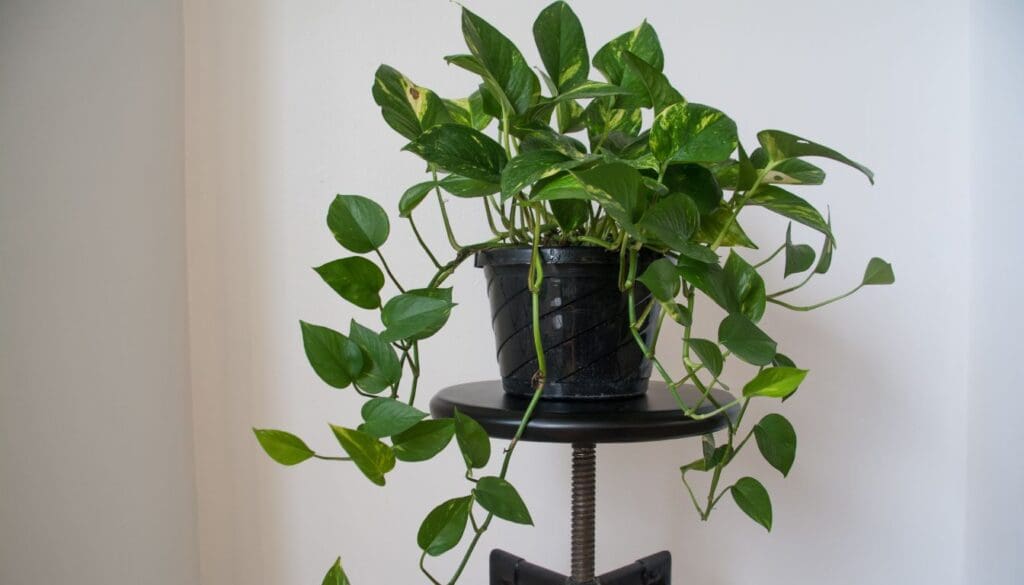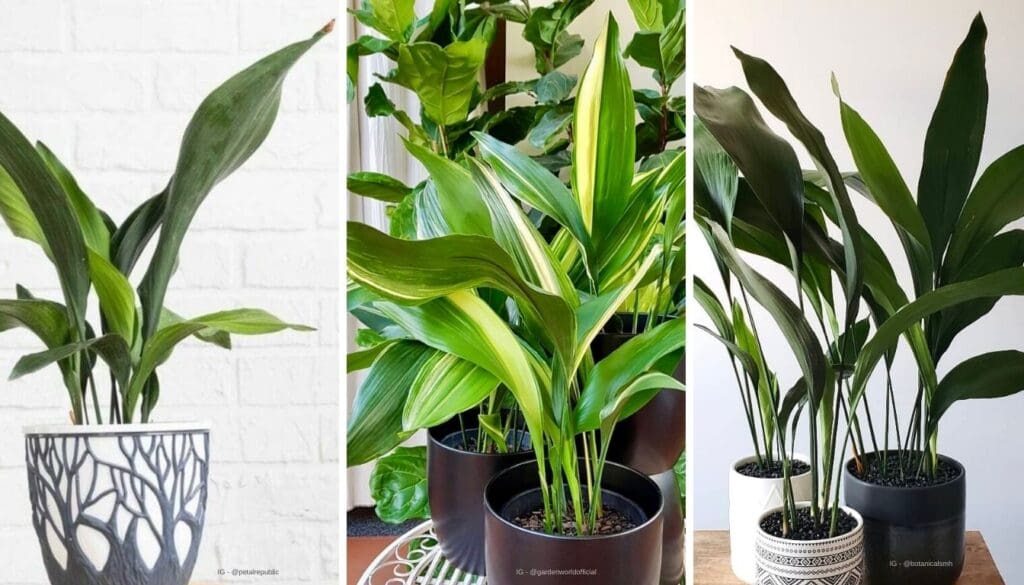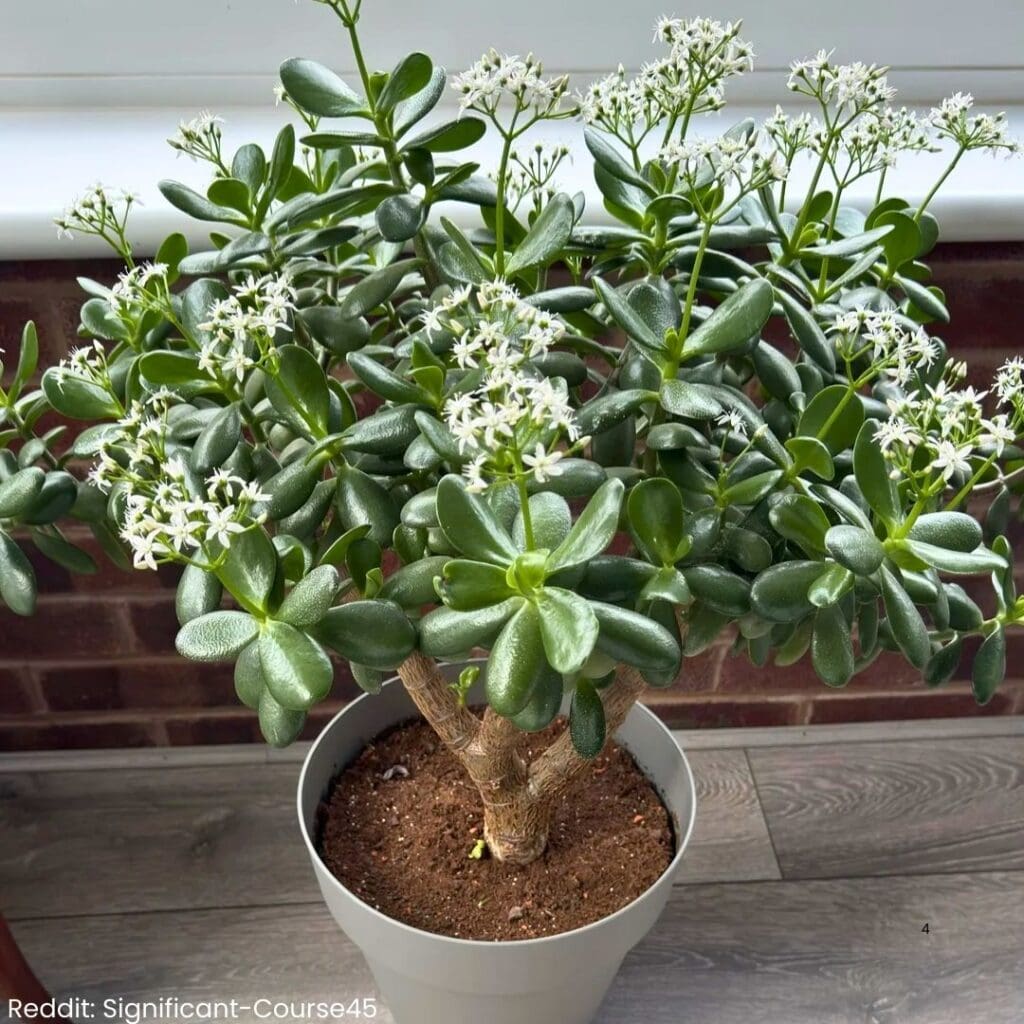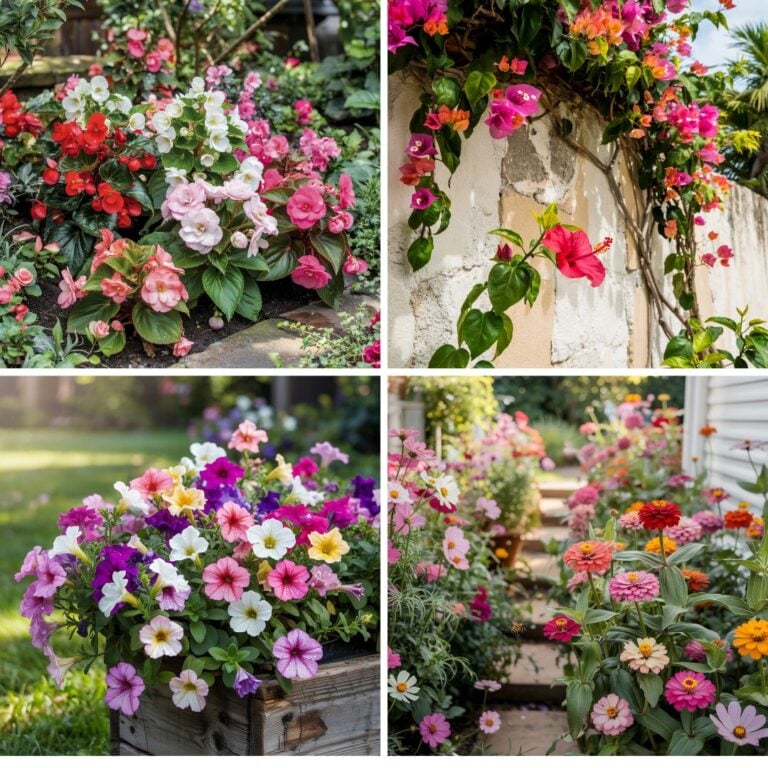10 Low-Maintenance Houseplants For Every Plant Parent
I really like having plants around, but honestly, I just don’t have the time to fuss over them. Some houseplants are way easier to look after than others, which is a lifesaver for folks like me who are always juggling a million things.
It’s just nice to see a splash of green without having to worry about constant care. These plants don’t mind a little neglect and still manage to brighten up the place.
Please note: Simplify Plants is reader-supported. As an Amazon Associate, I earn from qualifying purchases made by our readers with no extra cost added to you all! Some links in the post are affiliate links and I get a commission from purchases made through links in the post.
1) Snake Plant

The Snake Plant is easily one of my top picks for low-maintenance greenery. Some people call it Mother-in-Law’s Tongue, which always makes me laugh a little.
It’s got these tough, upright leaves with yellow or white edges—honestly, it looks good just about anywhere.
I love how sturdy this plant is. I forget to water it all the time, but it doesn’t seem to care. Every couple of weeks is usually enough, and it still manages to look healthy.
The Snake Plant is fine with different light conditions. Bright spots, shady corners—it’s not picky. If your place doesn’t get much sun, no big deal.
One thing I appreciate is that it’s supposed to help with air quality. It filters out some toxins, which makes me feel a little better about keeping it indoors.
I rarely have to trim the leaves, and pests don’t seem interested. That’s perfect for people who are busy or just starting out with plants.
It looks good in almost any pot. I’ve tried plain pots and colorful ones, and somehow the Snake Plant always manages to stand out.
Just don’t overwater it. I try to let the soil dry out between waterings to keep the roots happy.
If you want something simple to care for that still looks cool, I’d totally recommend the Snake Plant.
2) ZZ Plant

ZZ plants are ridiculously easy to keep alive. They’re famous for their thick, shiny leaves and sturdy stems, and honestly, they look a bit fake (in a good way).
I barely water mine because they store water in their roots. If you forget about your plants for a couple of weeks, the ZZ plant won’t even notice.
They’re also super chill about sunlight. Mine lives in a low-light corner and seems perfectly content. Low light isn’t a dealbreaker for this one.
Pests don’t really bother ZZ plants, which is a relief. I just dust the leaves every so often and they stay nice and glossy.
Heads up if you have pets: ZZ plants are toxic if eaten. I keep mine up high just in case.
I love that the ZZ plant grows slowly. There’s no need to trim it all the time, so it’s really low effort.
Those thick, dark green leaves just pop in any room. Friends always ask about it when they visit, probably because it looks so good with almost zero work.
For anyone who’s busy or just not great with plants, the ZZ plant is a tough, attractive choice that doesn’t ask for much.
3) Pothos

Whenever I want something easy, I think of pothos. It’s probably the simplest plant I’ve ever grown.
Pothos can handle almost any spot in the house, even if the light is kind of meh.
I just water mine when the soil feels dry. Sometimes that’s a week, sometimes two, and it doesn’t seem to care.
The vines look awesome hanging down or climbing up a support. The leaves have these cool white or yellow streaks that really stand out.
Pothos is happy in bedrooms, bathrooms—pretty much anywhere. It’s even fine in low light, as long as it’s not in harsh sun.
It’s also supposed to clean the air, which is a bonus. There are a bunch of varieties, like ‘Marble Queen’ or ‘Golden Pothos’, so you can choose your favorite look.
If I want more, I just snip a vine and let it root in water. It’s simple to multiply my pothos this way.
I don’t really worry about pests, but I’ll check the leaves from time to time. Pothos isn’t fussy about temperature either, so it survives whatever the season throws at it.
If someone asks me for the easiest plant to keep alive, I always say pothos. With just a little care, it keeps growing and makes any space look better.
4) Spider Plant

Spider Plants are about as easy as it gets. They’ll grow in so many places, even if the light isn’t great.
I just keep mine in indirect sunlight and it seems happy enough.
Watering is super straightforward. Once a week is usually fine, but if the soil feels dry, I’ll add a bit more. If I forget, it doesn’t seem to mind—these plants are really forgiving.
What’s cool is that Spider Plants help purify the air. I like knowing they’re quietly working in the background.
I get a kick out of seeing new baby plants pop up on those long stems. Sometimes I pot them up for friends, which is kind of fun.
My Spider Plant doesn’t have many issues with bugs or diseases. If a leaf turns brown or droopy, I just snip it off and the plant bounces right back.
If it gets too big, I’ll trim it or move it to a larger pot. It’s not fussy.
Spider Plants are safe for pets, which is a big deal in my house since my cat is always getting into things.
5) Peace Lily

I always have a Peace Lily around because it’s easy to care for. The glossy leaves look fresh, and those white flowers really brighten up a room.
Peace Lilies are fine with low light, so I don’t stress if my place isn’t super sunny. I just keep it away from direct sun and let it do its thing.
One thing I love is how the Peace Lily practically tells me when it’s thirsty. The leaves droop and it’s like, “Hey, water me!” Once a week is usually plenty.
I’ll wipe the leaves now and then to keep them clean, and maybe add a little plant food once in a while. But honestly, it thrives with very little attention.
It’s nice knowing the Peace Lily helps clean the air. I’ve read it removes some toxins, which makes me feel good about having it inside.
Just a heads up: it’s not safe for pets, so I keep mine out of reach.
You really don’t need any special skills for this plant. Even when I’m busy, the Peace Lily is easy to keep alive, and those blooms are a nice reward.
6) Cast Iron Plant

If someone asks me for a super easy plant, I always mention the Cast Iron Plant. It’s famous for being tough and can handle missed waterings and low light better than most plants.
Those dark green leaves grow slowly and look great. I hardly ever have to prune it, and pest problems are rare.
It does best in indirect light, but shade is fine too. Too much sun makes the leaves pale, so I avoid sticking it in a bright window.
Watering is simple—I just let the soil dry out between waterings.
It doesn’t need fertilizer very often, maybe once or twice a year. That’s honestly a relief.
The Cast Iron Plant usually stays around two feet tall, which is perfect for indoors. Those wide, glossy leaves really add a pop of green.
It’s also safe for pets, so I don’t have to stress if my cat or dog gets curious.
I’ve noticed it’s really disease-resistant. Even if I neglect it a bit, it just keeps growing. That’s why I always suggest it for beginners.
If you want something that asks for almost nothing and still looks good, the Cast Iron Plant is a solid pick.
7) Chinese Evergreen

I’m a fan of the Chinese Evergreen because it’s so easy to keep alive. Low light? No problem—I don’t even worry about it.
The leaves are this nice mix of green and silver, and they stay healthy even if I forget to water for a bit.
Chinese Evergreen doesn’t need much water. I just check if the top inch of soil is dry before watering. Too much water is actually worse.
It handles dry air and low sunlight, so it’s great for almost any room. Definitely a good pick for beginners.
It also helps clean the air, which is always a plus. There are lots of varieties, each with a slightly different look.
This plant grows slowly, so you don’t have to repot it all the time. Maybe every couple of years, tops.
Sometimes, the tips of the leaves go brown—usually from too much fertilizer or dry air. I just trim those off and it looks fine.
Wiping the leaves now and then keeps them dust-free and healthy.
The Chinese Evergreen is safe for most rooms, but I keep it away from pets since the leaves aren’t safe to eat.
All in all, it’s a great way to add some green to your space without much work.
8) Jade Plant

The Jade Plant is honestly one of my favorites because it’s just so easy to keep alive. I love those thick, glossy leaves and how sturdy the stems feel.
It looks good on a shelf or desk, and I only water it when the soil is dry to the touch. Overwatering is a big no-no, so I always let it dry out between waterings.
This plant is very drought-tolerant. Jade Plants like bright, indirect sunlight, so I keep mine near a window where it gets a few hours of light each day.
If it doesn’t get enough light, the leaves might turn soft or even fall off. One thing I really appreciate is how slow the Jade Plant grows.
It doesn’t need to be repotted much, and every so often I’ll wipe the leaves with a damp cloth to keep them shiny. If I want to grow a new Jade Plant, it’s honestly simple.
I just take a healthy leaf, let it dry out for a few days, then stick it in some soil. Usually, it grows roots without much fuss.
The Jade Plant is also known for its long life, sometimes living for many years if you treat it right. Some folks even call it a “money plant,” and say it brings good luck.
For me, the Hardy Jade Plant is an easy, attractive choice. Even if I forget to water it now and then, it just keeps going—perfect for busy people like me.
9) Parlor Palm

I love how easy the Parlor Palm is to care for. It does fine even if I forget to water it for a few days, and those green, feathery leaves make any room feel fresher.
The Parlor Palm can handle low light, which means I don’t have to stress about finding a sunny spot. Mine sits in a corner of my living room and still looks healthy.
I usually water my Parlor Palm once a week, letting the soil dry out between waterings to avoid root rot. This plant definitely doesn’t like soggy soil.
I don’t bother with special plant food very often—a balanced fertilizer every couple of months is enough. It grows slowly, so I barely ever need to re-pot it.
Pets are safe around Parlor Palms since they’re non-toxic. I never worry if my cat decides to brush against the leaves.
If I notice dust, I just wipe the leaves with a damp cloth to keep them looking fresh. This plant does not need much trimming, either.
If I see a brown leaf, I snip it off at the base and toss it. The Parlor Palm brings a touch of nature indoors without much effort.
For me, it’s one of the best choices for anyone who wants something green but doesn’t have a lot of time.
10) Rubber Plant

I really like the Rubber Plant for its toughness and the way it stands out in a room. The leaves are thick, shiny, and that deep green is just eye-catching.
This plant doesn’t ask for much. I water it when the top inch of soil feels dry, and it can handle a missed watering here and there.
I keep my Rubber Plant near a bright window, but not in direct sun. Bright, indirect light keeps the leaves looking their best, but too much sun can burn them.
If it gets dusty, I just wipe the leaves with a damp cloth. Clean leaves help the plant breathe better.
The Rubber Plant isn’t fussy about fertilizer. I use a weak liquid one about once a month in spring and summer.
I try to rotate the pot every now and then so all the leaves get some light, which helps it grow evenly. One cool thing is that the Rubber Plant can get really tall if you let it.
If I want it shorter, I’ll just trim the stems and it stays compact. Pets and kids need to stay away from the Rubber Plant since the sap can be a bit irritating.
I always wash my hands after pruning or moving it, just to be safe. For me, the Rubber Plant is a great pick because it’s easy to care for and looks good all year.
Even if I forget about it sometimes, it still does fine.
Essential Care Tips for Low-Maintenance Houseplants
I’ve noticed that healthy plants mostly need the right amount of water, decent light, and the right soil. If you get those three things down, caring for houseplants gets a lot easier.
Watering Guidelines
Watering seems simple, but it’s surprisingly easy to mess up. I always check the soil before watering—if the top inch is dry, that’s my cue.
Most low-maintenance houseplants like to dry out a bit between waterings. Too much water can cause root rot, so I use pots with drainage holes and water slowly until water comes out the bottom.
Here’s a little table I use for reference:
| Plant Type | Watering Frequency |
|---|---|
| Snake Plant | Every 2-3 weeks |
| Pothos | Every 1-2 weeks |
| ZZ Plant | Every 2-3 weeks |
| Spider Plant | Once a week |
I water less in winter when plants slow down. Room-temperature water works best, and I try not to splash the leaves.
Light Requirements
Good light really makes a difference. I keep most of my easy plants in medium to bright, indirect sunlight.
Direct sun can burn leaves, especially for things like pothos or peace lily. For rooms with not much natural light, I use LED grow lights.
Rotating the plant every few weeks helps it grow evenly. Some examples:
- Snake plant: Tolerates low light but loves bright, indirect light.
- Pothos: Does well in low to medium light.
- Peace lily: Needs bright, filtered light to bloom.
If leaves look pale or stems get leggy, I move the plant to a brighter spot.
Soil and Potting Advice
I usually go for well-draining potting mix for most of my houseplants. Cactus or succulent mixes are great for plants that hate wet roots.
For others, I mix regular potting soil with some perlite to help drainage. Repotting is important if roots fill the pot or start poking out the bottom.
This gives plants more space and keeps them healthier. Proper pots make a big difference.
I always pick pots with drainage holes and avoid going too big—too much soil can hold too much water. I never use garden soil indoors; it’s just too heavy.
Common Challenges and How to Overcome Them
Keeping houseplants alive is usually easy, but problems do pop up. Spotting early signs and knowing what to do helps keep my plants happy.
Recognizing Signs of Stress
I keep an eye out for yellow leaves, wilting, or brown tips. These usually mean there’s too much or too little water.
If a plant looks droopy but the soil is wet, I let it dry out before watering again. Leaf drop can happen if a plant moves to a spot with less light.
I try to place my plants where they’ll get the right amount of sun. I also check for spots or soft stems, which can mean overwatering or rot.
A quick finger test of the soil before watering helps a lot. Watching the leaves every week makes it easier to catch issues early.
Preventing Pests and Diseases
Sometimes I spot little bugs like spider mites, mealybugs, or aphids. I wipe leaves with a damp cloth and use soapy water if bugs show up.
Here’s what I do to keep pests away:
- Clean leaves regularly
- Avoid overwatering
- Give each plant enough space for airflow
If I see mold or mildew, I make sure the room isn’t too humid. White fuzz or sticky stuff gets trimmed off right away.
Healthy, clean plants get fewer pests and disease problems. I keep my pots clean and don’t let water sit at the bottom.
Frequently Asked Questions
People ask me all the time about houseplants that don’t need much care. There are plenty of tough plants that stay healthy even if you forget about them now and then.
What are some popular indoor plants that require minimal attention?
I always suggest the Snake Plant and ZZ Plant. They don’t need much water and can handle low light.
My Pothos also grows well, even if I forget to water it.
Can you recommend hardy plants that thrive in low-light conditions?
The Snake Plant is great for spots with barely any sun. The ZZ Plant is another top choice for dark corners.
Both keep their leaves looking nice, even far from windows.
Which small indoor plants are known for their resilience and easy care?
I think Spider Plants and small Pothos are perfect if you want something tough and compact. They survive even if I skip watering for a while.
Peace Lilies can handle some neglect too and don’t mind shade.
What are the best houseplants for someone with a busy lifestyle?
If you’re busy like me, the ZZ Plant and Snake Plant are super forgiving. They hardly ever need water, and as long as they’re out of direct sun, they just keep growing.
Which indoor plants can survive with limited direct sunlight?
I’ve found that Pothos, Snake Plant, and Peace Lily all stay green in spots without much sun. My bathroom and hallway do fine with these.
They really don’t seem to mind being away from bright windows.
Could you suggest some durable outdoor plants that are easy to maintain?
For outdoor spaces, I’d go with succulents like Aloe Vera or the trusty Jade Plant. They barely need any watering, which is honestly a relief if you forget sometimes.
I’ve also had good luck with Hostas and Daylilies. Both seem to handle heat and dry spells way better than most plants in my yard.
Recommended Garden Supplies
| Product Image | Our Recommended Gardening Supplies | Check Offers! |
|---|---|---|
Top Top
Top
Top
Top
Top
Top
Top
Top | rePotme Houseplant and Tropical Classic Potting Soil Mix | Check Offer On Amazon |
 Top
Top
Top
Top
Top
Top
Top
Top | Espoma Organic Indoor Plant Food | Check Offer On Amazon |
 Top
Top
Top
Top
Top
Top
Top
Top | GooingTop LED Grow Light 6000K Full Spectrum Clip Plant Growing Lamp | Check Offer On Amazon |
 Top
Top
Top
Top
Top
Top
Top
Top | Soil Moisture Meter | Check Offer On Amazon |
 Top
Top
Top
Top
Top
Top
Top
Top | Govee Hygrometer Thermometer, Bluetooth Enabled! | Check Offer On Amazon |
 Top
Top | LEVOIT Humidifiers for Large Room(Best For Plants) | Check Offer On Amazon |
 Top
Top
Top
Top
Top
Top
Top
Top | Upgraded DIY Automatic Drip Irrigation Kit, 15 Potted Houseplants Support | Check Offer On Amazon |
 Top
Top
Top
Top
Top
Top
Top
Top | Stainless Steel Heavy Duty Gardening Tool Set | Check Offer On Amazon |
 Top
Top
Top
Top
Top
Top
Top
Top | Bonide Insecticidal Soap | Check Offer On Amazon |
 Top
Top
Top
Top
Top
Top
Top
Top | Bonide 32 oz Spray Neem Oil for Organic Gardening | Check Offer On Amazon |
 Top
Top
Top
Top
Top
Top
Top
Top | Garden Safe Fungicide | Check Offer On Amazon |






